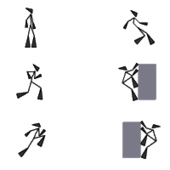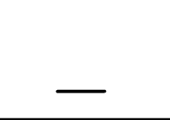Stick figure

A stick figure is a highly stylized image of a person whose limbs are represented only by simple lines. Basically, a distinction can be made between hand-drawn stick figures and stick figures in the form of vector graphics .
Stick figures reduce a living being to the essentials. Nevertheless, stick figures are very good at expressing feelings and emotions, which is why stick figure faces were used as templates for emoticons . Even if stick figures are two-dimensional (2D), they can also be represented in three dimensions (3D), especially in films or kinematic representations.
Static stick figure

Similar to cephalopods , stick figures are a typical element of children's drawings towards the end of the cephalopod phase - an early stage in learning to draw.
Stick figures often appear in pictograms in order to convey information independently of the language or as quickly as possible, for example on many traffic signs .
In the Unified Modeling Language , stick figures are used to represent actors .
Stick figures have also found their way into works of art. Since 1960/61, for example, they have often been found on paintings by AR Penck . According to Lucius Grisebach, they illustrate "in their posture and their action an event, relationships, forces." The stick figures are also typical of Keith Haring's works. Another artist who expresses his intentions by drawing or spraying stick figures is Harald Naegeli , the “Sprayer of Zurich”. Matt Mullican has created a series of drawings of the stick figure “Glen”, who questions the perception of art.
Stick figures also appear in literature, for example in the Sherlock Holmes story The Adventure of the Dancing Men . Stick figures are particularly common in cartoons and comics. Much older evidence of stick figures can be found in hieroglyphic writing (a pictorial font and the oldest written form of ancient Egyptian language).
Stick figure in motion

Stick figures are often used for animations , especially because of their simple structure . B. in flip books .
The stick figure film career began early and is not over yet. As early as 1908 , the film "Fantasmagorie" by Émile Cohl was made. In recent years a number of other stick figure short films have been made by various filmmakers. These are mostly programmed as vector graphics in Flash, e.g. B. “ XiaoXiao ” by the Chinese artist Zhu Zhiqiang or “The Course” by Will Saunders.
Game developers have also discovered stick figures for themselves, e.g. B. Istvan Orosi with the flash game series “Stickman Sam”, Robin Allen with “Hapland”, “ N ” from Metanet Software or Zhu Zhiqianq with XiaoXiao .
In sports science , stick figure representations are used for the kinematic recording and analysis of motion sequences as well as to clarify movements. Sports activities can be recorded with video cameras and converted into stick figure representations using special software . The conversion is based on models that divide the human body into a different number of segments. Hodgins used to represent a gymnast z. B. 15 segments, the much more complex "Jack" model 69 segments.
literature
- Ekkehard Drechsel: Learning to draw is a lot of fun . Moewig, Rastatt 2005, ISBN 3-8118-2939-4 .
- Institut Jugend Film Fernsehen (ed.): Central Filmography of Political Education A / I.–IV. Catalog . Leske + Budrich, Wiesbaden 1998, ISBN 3-8100-0279-8 .
- Jürgen Leykamm: Period . Point. Coma. Line ... look death in the face. History of an accident with a life consequence and nowhere in between . Verlag Meyer, Scheinfeld 2004, ISBN 3-89014-222-2 ( near-death experience after a traffic accident).
- Nicole Rechia: Warning. Failure; to buy this book could result in death or serious injury . Mark Batty Publ., New York 2005, ISBN 0-9725636-9-5 .
See also
- La Linea , the line man of the Italian cartoonist Osvaldo Cavandoli
- Mimih , a mythological Aboriginal spirit as a stick figure

